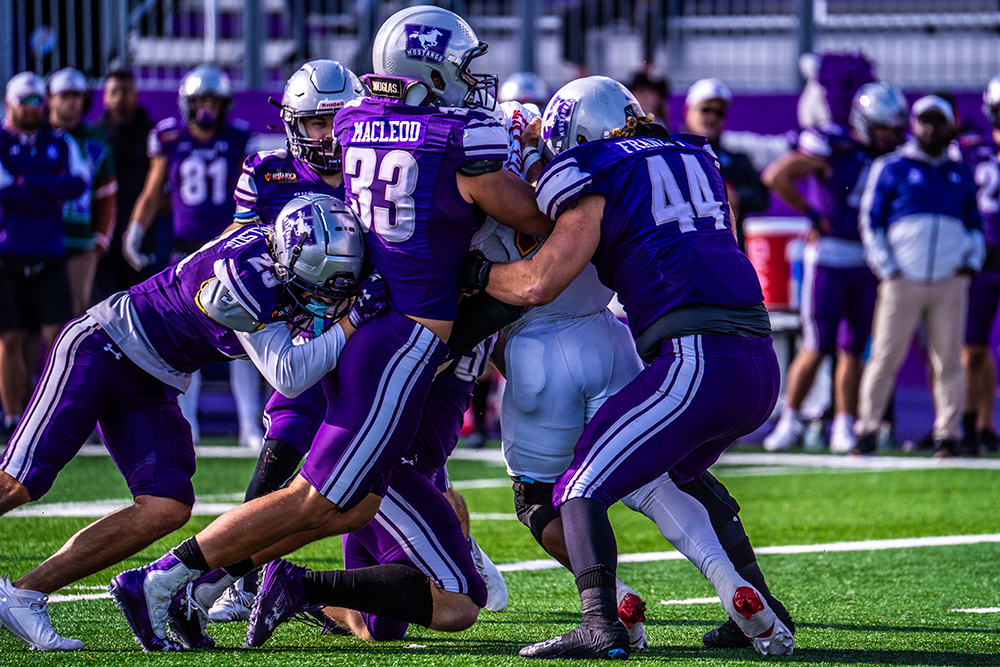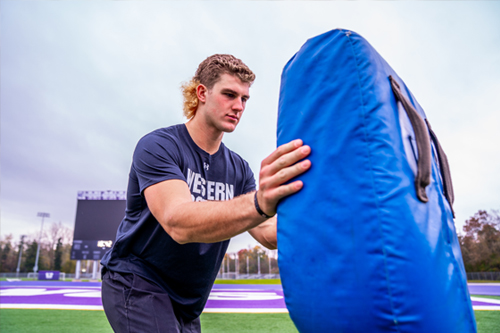Media
Contact
Communications Specialist
Faculty of Engineering
Spencer Engineering Building
Room 2072
Western University
Tel: 519-661-2111 ext. 87015
Email: engineeringcomms@uwo.ca
Western Engineering research tackles football wrist injuries: A student’s journey in balancing academics, athletics and innovation

Engineering student-athlete Riley Macleod (#33) leads the charge as the Western Mustangs defence comes together for a dominant tackle. (Jacob Arts/Western Engineering)
At Western University’s Faculty of Engineering, the student experience is more than academics—it’s about transforming knowledge into action and passion into research. For Riley Macleod, a dedicated student in the School of Biomedical Engineering and the department of mechanical and materials engineering, as well as a linebacker on Western’s football team, this means exploring the physical toll of the game he loves.
This year, under the guidance of Emily Lalone, professor in the department of mechanical and materials engineering and School of Biomedical Engineering, Macleod embarked on an interdisciplinary research project to understand the mechanics of wrist injuries among football players. Football is a collision-heavy sport, and wrist injuries are common, but few studies have explored the underlying biomechanics. Macleod’s unique experience as an athlete and engineering student has allowed him to bridge theory and practice in ways that resonate deeply with his peers and future football players alike.
The Inspiration and Drive Behind the Study
For Macleod, the project is personal. His own experiences with wrist soreness on the field motivated him to seek out Lalone as a supervisor. "Football is such a physically intense sport," Macleod explains. "Studying a part of the body that undergoes a heavy load each week can hopefully lead to better awareness and allow players to treat their bodies with the care they need."
Macleod's background as both an engineering student and an athlete is central to the project’s focus. He understands firsthand the physical demands placed on players and brings a unique perspective to the study. This combination of academic rigour and athletic insight has guided the research direction, helping the team identify relevant data to capture and analyze.
Lalone, who specializes in hand and upper limb biomechanics, saw potential in Macleod’s proposal. “Macleod initially approached me as he was finishing his fourth year and mentioned that his wrists and those of his teammates often felt sore after games,” she shared. Intrigued by the frequency of hand-related impacts during gameplay, they reviewed footage and found that wrist contact was indeed frequent and forceful.
Connecting with Clinical Specialists
To explore the issue further, Lalone and Macleod reached out to Dr. Assaf Kadar, a hand surgeon at the Roth | McFarlane Hand and Upper Limb Centre, as well as Dr. Vishal Kalia, an MSK radiologist at St. Joseph’s Health Care, along with his colleague Dr. Itay Shavit. These clinicians suspected that there might be tendinopathy due to overuse of the hands in sports. A brief review of the literature suggested that this area was under-researched, prompting the team to delve deeper. They decided to partner with professor Aaron Fenster’s lab, leveraging its expertise in 3D ultrasound imaging to visualize tendons within the various compartments of the hand. This setup provided a robust approach to examining and understanding potential tendon issues.
A detailed protocol was developed in collaboration with radiologists and ultrasonographer Mary-Ellen Empey to ensure repeatable and clinically useful images were obtained. Additionally, they collaborated with professor Dave Humphreys, a physical therapist and professor in the School of Kinesiology, to create a battery of tests assessing hand and wrist function, including measures of grip strength and joint laxity.
Pioneering Technology Aligned with NFL Initiatives

Riley demonstrates a blocking posting during training with a tackling dummy. (Jacob Arts/ Western
Engineering)
One of the primary goals of this research is to develop a better understanding of the forces and stresses that athletes’ wrists endure during gameplay. The pair are working with Jake Reeves, who is a mechanical engineer and professor at Western who has expertise in impact biomechanics. Together, they are creating a specialized loading device—a blocking simulator that measures the force experienced by the wrist, drawing inspiration from devices used to study trauma in car accidents.
“I think technology such as this loading device can provide better insight into what athletes are actually going through in competition,” Macleod noted. “There is not a large understanding of the loads and stresses that the human body undergoes during sports, and I think it will be very beneficial to understand the mechanical forces that occur during competition.”
The NFL recently launched the Contact Detection Challenge to leverage artificial intelligence (AI) in injury prevention. Lalone sees an exciting alignment between their research and the NFL’s initiative. “Our study aligns with the NFL’s goal to measure and analyze player contact using AI. We are developing AI-based tools that can track player positions and contact points throughout play, contributing to the grand challenge of determining where and when athletes can get injured.”
Macleod agrees that AI could be transformative in sports safety research. “Manually tracking contacts is time-consuming, but with AI, we could analyze many more games faster and more efficiently, helping us further understand injury risks.”
Goals for Future Impact
Ultimately, Macleod and Lalone hope their research will lead to better injury prevention strategies. “I hope this research brings more knowledge and awareness to the effects that repeated impacts can have on an athlete’s body,” Macleod said. While wrist injuries may not receive the same attention as concussions, they can still have long-term implications if left unaddressed.
For Lalone, the project highlights the importance of evidence-based practices. “In youth baseball, pitch counts are in place to prevent joint injury and ensure player longevity,” she said. “We envision something similar for football—a way to understand and mitigate the impact of play on the hand and wrist joints. Currently, players wear hand guards or tape their wrists, but these practices are not evidence-based. This study will allow us to evaluate their effectiveness and improve them.”
A Unique Learning Experience for Students
Balancing a demanding engineering program with football is no small feat, but Macleod credits supportive coaches and professors for helping him succeed. “Time management is crucial. Football and school each require a lot of commitment, and without the support I’ve had, it would be difficult to excel at both,” he says. Faculty members like professor Lalone work closely with student-athletes, allowing them to meet both academic and athletic responsibilities, which is a key aspect of the student experience at Western.
Professor Lalone emphasizes that this project exemplifies Western Engineering’s commitment to student-led research and interdisciplinary collaboration. With support from clinicians, radiologists, and physical therapists, Macleod’s project is a convergence of expertise across fields, illustrating the value of practical applications in engineering studies.
“Macleod’s leadership and passion for his work have rallied an impressive team to tackle a real-world problem,” says Professor Lalone. “This type of project offers our students invaluable hands-on experience and fosters connections with the broader research and athletic communities.”
As the study progresses, the dynamic duo look forward to expanding their research. “We’re just scratching the surface,” Lalone said. She is already encouraging Riley to consider a PhD, jokingly adding, “even if he makes it to the CFL—I’ll be flexible!” This work could set the stage for a future where football players are better equipped to protect their bodies, thanks to innovations coming out of Western Engineering.
At Western’s Faculty of Engineering, projects like Macleod’s showcase the transformative power of student-led research, where passion meets innovation and students make meaningful contributions that could shape the future of sports safety.
Macleod hopes the findings will go beyond Western's field, benefiting athletes at all levels. “While wrist injuries may not be as prominent as head injuries, they can still lead to complications if neglected," he says. This sentiment aligns with recent trends in sports research, where there is a growing emphasis on preventing long-term damage through detailed biomechanical studies.

